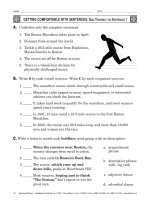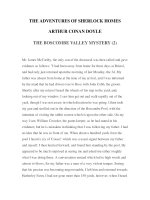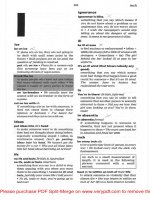4 2 4 lumberjacks
Bạn đang xem bản rút gọn của tài liệu. Xem và tải ngay bản đầy đủ của tài liệu tại đây (5.12 MB, 10 trang )
Suggested levels for Guided Reading, DRA,™
Lexile,® and Reading Recovery™ are provided
in the Pearson Scott Foresman Leveling Guide.
by Ann Parrott
Genre
Expository
nonfiction
Comprehension
Skills and Strategy
• Fact and Opinion
• Draw Conclusions
• Monitor and Fix Up
Text Features
• Captions
• Heads
• Glossary
Scott Foresman Reading Street 4.2.4
ISBN 0-328-13436-8
ì<(sk$m)=bdedg < +^-Ä-U-Ä-U
Vocabulary
cord
dismay
grizzly
immense
payroll
Reader Response
1. A fact is something that can be proved. An
opinion is what someone believes, thinks, or feels.
Reread pages 6 and 7 to find statements of fact
and opinion. Write your answers in a chart similar
to the one below.
Lumberjacks
by Ann Parrott
Fact
Opinion
Word count: 1,110
2. Did you have any questions while you were
reading? What did you do to answer your
questions?
3. Use the word immense in a sentence that shows
what it means.
4. Look at the picture of Paul Bunyan on page 3.
What can you tell about his size from the picture?
illustrated by Burgandy Beam
Note: The total word count includes words in the running text and headings only.
Numerals and words in chapter titles, captions, labels, diagrams, charts, graphs,
sidebars, and extra features are not included.
Editorial Offices: Glenview, Illinois • Parsippany, New Jersey • New York, New York
Sales Offices: Needham, Massachusetts • Duluth, Georgia • Glenview, Illinois
Coppell, Texas • Ontario, California • Mesa, Arizona
Paul Bunyan: Lumberjack
Old stories say that Paul Bunyan was a giant
lumberjack, or logger. When he was born, his father
used five trees to make his cradle. As he grew, Paul
needed a lot to eat. His hotcakes were cooked on a
huge griddle. Men greased it using bacon as skates!
Paul grew so big that his footprints filled with water and
became lakes.
Paul’s pet, Babe the Blue Ox, was huge too. The
space between Babe’s eyes was longer than forty-two
axe handles.
Of course, Paul Bunyan was not a real man. But
loggers in the United States in the 1800s were strong
and tough workers. They liked to brag about their
strength and to tell tall tales about heroes like Paul
Bunyan. Their stories made workdays pass quickly.
Every effort has been made to secure permission and provide appropriate credit for
photographic material. The publisher deeply regrets any omission and pledges to
correct errors called to its attention in subsequent editions.
Unless otherwise acknowledged, all photographs are the property of Scott Foresman,
a division of Pearson Education.
Illustrations by Burgandy Beam
ISBN: 0-328-13436-8
Copyright © Pearson Education, Inc.
All Rights Reserved. Printed in China. This publication is protected by Copyright,
and permission should be obtained from the publisher prior to any prohibited
reproduction, storage in a retrieval system, or transmission in any form by any
means, electronic, mechanical, photocopying, recording, or likewise. For information
regarding permission(s), write to: Permissions Department, Scott Foresman, 1900 East
Lake Avenue, Glenview, Illinois 60025.
4 5 6 7 8 9 10 V0H3 14 13 12 11 10 09 08 07 06
3
The Discovery of Gold and Other Treasure
At an Early Logging Camp
The cry of “Gold!” brought thousands of people
west to California around 1849. All these people needed
homes, and lumber was needed to build these homes.
There was lots of work for lumberjacks.
Soon lumberjacks heard of another kind of
“treasure” farther north. According to the stories, there
were huge trees in immense forests. Some of the biggest
trees are called redwoods. Many lumberjacks headed
north to find the big trees.
After lumberjacks found an area good for logging,
they built a logging camp. The men lived there for
months while they cut logs. A logger’s shanty, or house,
was not fancy. It had a big fireplace in the middle for
cooking and heating. A hole in the roof let out the
smoke.
Loggers slept on bunks with straw mattresses. They
kept all their belongings near their bunks. Loggers even
sat on their bunks to eat.
The inside of a logger’s shanty
might have looked like this.
4
5
The lumberjacks needed to eat a lot of food because
they worked so hard. Their breakfast might have
included oatmeal, prunes, pork and beans on toast,
raisin pie, cheese, and bread and butter. Hot tea always
finished a meal.
Lumberjacks carried their lunches—maybe pork and
cheese sandwiches—out to their work site in the forest.
They usually ate two lunches, one at 9:00 A.M. and
the other at 1:00 P.M. The cook often served supper
around 7:00 P.M. Supper might have included pea soup,
beef, pork and mustard, sugar pie, raisin pie, molasses
cookies, cheese, bread and butter, milk, and, of course,
hot tea.
The first step in lumbering was to chop down a
tree. This is not too difficult with a small tree, but the
redwood trees of California are huge. They can be
fifteen feet wide near their base. Loggers started by
building a platform a few feet off the ground. The tree
was not as thick there. They stood on the platform to
chop down the tree. It took a two-man team several
days to cut down a large redwood. These men had to
plan carefully to do the work safely. They also had to
watch out for dangerous animals, such as grizzly bears.
The rule at some logging camps
was “No talking. Eat quickly.”
6
7
Once a tree was chopped down, the loggers had to
move it out of the forest to a sawmill. Then the tree was
cut into lumber. To get ready for the move, lumberjacks
cut off branches and bark. Then they used horse or
oxen teams and their own strength to roll the logs down
to a rough road.
The road, called a “skid road,” was made of logs
laid a few feet apart. These logs, or skids, were partly
pressed into the ground. Horses or oxen pulled the cut
logs across the skids. Loggers would grease the skids
with oil or water. This made the cut logs slide easily.
Down to the River
The logs were pulled to a nearby river. The
lumberjacks built a dam in the river to collect the logs.
Once the river was full of logs, it was time to send
them downstream to a sawmill. This was dangerous.
Often the logs were jammed so tightly in the river that a
dynamite blast was needed to start the logs on their trip.
As the logs moved, loggers climbed on top to guide
them. If a logger fell, he could easily be hurt or even
killed by the heavy logs. Loggers were eager to reach
the sawmill. That was where the payroll was worked
out so the loggers could get paid.
This skid road was so slippery with ice that
just two horses could pull all these logs.
8
9
10
At the Sawmill
Improvements in the Process
Water did most of the work at sawmills. The force
of the rushing water turned a waterwheel. The turning
waterwheel powered the saws that cut the logs.
With a loud roar, saws cut planks from the logs.
Sawdust filled the air. Men carried the planks to big
tables. Then they sorted them by size. Next, they piled
the planks beside the mill in a lumberyard.
A steam-powered engine called a donkey was made
to move logs from the forest to the river. One kind of
donkey engine was built by a man who used to work on
ships. He changed a ship’s lifting device to make it work
in the woods.
11
Later, loggers began using railroads to get logs to a
sawmill. Lumberjacks no longer had to ride their logs
down the river to the sawmill. Donkey engines loaded
logs onto railway cars to be taken to the sawmill.
Strong bridges were built to carry train tracks across
valleys. To everyone’s dismay, trains sometimes fell
from the tall bridges.
Pulling heavy logs
took a lot of power.
12
Whistle Signals
Logging railroad whistles sent messages. Each
whistle had a special meaning:
Short whistle: Stop.
Two long whistles: Go.
Three short whistles: Back up.
Two long and two short whistles: Train crossing
highway.
Eight long whistles: Train coming into a station.
Many short whistles: Warning! A person or animal
on the track.
Railroad inspectors like this
one checked on safety.
13
Native Americans’ Use of Forests
Modern-Day Logging
Long before the loggers came to cut down trees,
Native Americans lived in the woods and used the
resources of the forest.
Native Americans used all parts of the tree. They
made harpoons, axe handles, and fish net poles from
tree branches. They wove baskets from small tree roots.
Tree needles were used to make tea. The trees also
provided shelter.
Lumberjacks later used this forest for the logging
industry.
The newest machine in the logging industry is the
skyhook, a helicopter with a long metal cable hanging
from it. Cut trees can be attached to the cable. A
skyhook can lift many cords of wood, up to eleven
thousand pounds! A cord of wood is a pile four feet
wide, four feet high, and eight feet long.
Even today, lumberjacks work hard in forests across
the United States. Some of them still like to retell the
old Paul Bunyan stories to pass their time!
Native American redwood bark house
14
15
Glossary
Vocabulary
cord
cord
n. a measure of
quantity for cut wood,
dismay
equal
to 128 cubic feet;
a pile of wood four feet
wide,
four feet high,
grizzly
and eight feet long.
immense
dismay
n. sudden,
helpless fear of what
is payroll
about to happen or
what has happened.
Reader Response
immense adj. very
large; huge; vast.
payroll n. a list of
persons to be paid and
the amount that each
one is to receive.
1. A fact is something that can be proved. An
opinion is what someone believes, thinks, or feels.
Reread pages 6 and 7 to find statements of fact
and opinion. Write your answers in a chart similar
to the one below.
Fact
Opinion
grizzly n. grizzly bear; a
Word
count:
1,110
large, gray
or brownishgray bear of western
North America.
2. Did you have any questions while you were
reading? What did you do to answer your
questions?
3. Use the word immense in a sentence that shows
what it means.
4. Look at the picture of Paul Bunyan on page 3.
What can you tell about his size from the picture?
Note: The total word count includes words in the running text and headings only.
Numerals and words in chapter titles, captions, labels, diagrams, charts, graphs,
sidebars, and extra features are not included.
16









